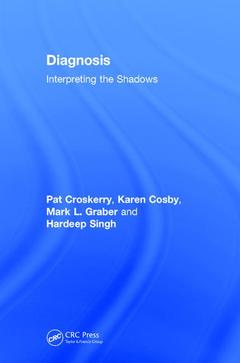Diagnosis Interpreting the Shadows

Preface; Section I: Models of Diagnosis; Chapter 1: What is Diagnosis?; Chapter 2: Medical Decision Making; Chapter 3: Modern Cognitive Approaches to the Diagnostic Process; Section II: Informal and Alternative Approaches to Diagnosis; Chapter 4: Alternatives to Conventional Medical Diagnosis; Chapter 5: Complementary and Alternative Medicine; Section III: The Elements of Reasoning; Chapter 6: Stone Age Minds in Modern Medicine: Ancient Footprints Everywhere; Chapter 7. Cognitive and Affective Biases, and Logical Failures; Chapter 8: The Rational Diagnostician; Chapter 9: Individual Variability in Clinical Decision Making and Diagnosis; Section IV: Challenges and Controversies in Diagnosis; Chapter 10: Diagnostic Error; Chapter 11: The Role of the Healthcare System in Diagnostic Success or Failure; Chapter 12: Do Teams Make Better Diagnoses?; Chapter 13: How Much Diagnosis Can We Afford?; Section V: The Fix; Chapter 14: Medical Education and the Diagnostic Process; Chapter 15: Cognitive Bias Mitigation: Becoming Better Diagnosticians; Chapter 16: Diagnostic Support from Information Technology; Chapter 17: What is the Patient’s Role in Diagnosis?; Appendix A. Cognitive Biases; Appendix B. Logical Fallacies; Glossary; Afterward
Pat Croskerry is Professor of Emergency Medicine and in Medical Education at Dalhousie University in Halifax, Nova Scotia, Canada. He has been a contributor to the annual conference of the Society for Improvement in Diagnosis since its inception. He has published over 80 journal articles and 30 book chapters in the area of patient safety, clinical decision making and medical education reform. In 2006 he was appointed to the Board of the Canadian Patient Safety Institute, and in the same year received the Ruedy award from the Association of Faculties of Medicine of Canada for innovation in medical education. He is senior editor of Patient Safety in Emergency Medicine (2009). He was appointed Director of the new Critical Thinking Program at Dalhousie Medical School, and a Fellow of the Royal College of Physicians of Edinburgh in 2012. In 2014, he was appointed to the US Institute of Medicine Committee on Diagnostic Error in Medicine.
Karen Cosby is a senior Emergency Medicine Physician at Cook County Hospital and Associate Professor at Rush Medical School. Her career interests include medical education, clinical decision-making, and patient safety. She has chaired the Fellowship subcommittee of the Society to Improve Diagnosis in Medicine (SIDM) and the patient safety interest group for the Society for Academic Emergency Medicine (SAEM) where she led efforts to produce a curriculum for patient safety. She was a co-investigator of an AHRQ grant on diagnosis error. She has edited three textbooks (including Patient Safety in Emergency Medicine). Her contributions to patient safety include a framework for classifying factors that contribute to error in emergency medicine, and a 15-year review of patient care management problems identified in M&M reviews. Her main career focus is investigating and understanding medical failure and improving education to meet the needs of an increasingly complex healthcare system.
Mark L Graber is P
Date de parution : 07-2017
15.6x23.4 cm
Date de parution : 05-2017
15.6x23.4 cm
Thèmes de Diagnosis :
Mots-clés :
Intelligence Advanced Research Projects Activity; diagnostic; Cauda Equina Syndrome; failure; Necrotizing Fasciitis; error; Diagnostic Failure; affective; Search Satisficing; bias; Affective Bias; reasoning; Diagnostic Errors; clinical; Lay Referral System; cognitive; Myside Bias; biases; Great Rationality Debate; process; Algorithmic Mind; Karen Cosby; Dual Process Model; Pat Croskerry; Blind Spot Bias; Cosby Cosby; Clinical Practice; Mark L; Graber; Clinical Reasoning; Croskerry Pat; Diagnostic Reasoning; Proactive Coping Inventory; Mindware Gaps; Mindful Attention Awareness Scale; Illness Script; Medical Decision Making; Wrong Site Surgery; Emergency Physician; BMJ Qual; DSM Disorder
